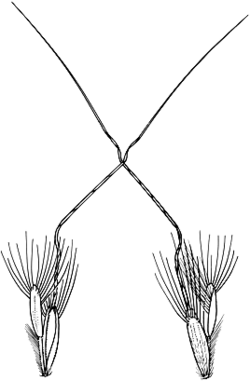Common name: Queensland Bluegrass
Dichanthium sericeum (R.Br.) A.Camus APNI* Synonyms: Dichanthium sericeum S.T.Blake APNI*

Description: Erect perennial to 1.2 m high.
Leaves with sheath sprinkled with tubercle-based hairs; ligule c. 1 mm long; blade 2–4 mm wide, sometimes sprinkled with tubercle-based hairs.
Racemes 1–6, often bluish and white-villous, 4–7 cm long; lowest pairs of spikelets sterile, reduced to the glumes, subpersistent; joints and pedicels with hairs increasing upwards to 1.5 mm long. Sessile spikelets c. 4 mm long; callus obtuse, shortly and densely bearded. Lower glume shortly pilose in the lower half, long ciliate on the keels in the upper part and on a transverse subapical arch with tubercle-based cilia to 6 mm long; upper glume subequal. Lower lemma c. 1.5–2.5 mm long, sterile; upper lemma stipe-like with an awn c. 25 mm long. Pedicellate spikelets sterile, c. 3 mm long, reduced to the glumes or the lower lemma occasionally present. Anthers 1 mm long. Grain 1–2 mm long.
Flowering: mostly summer.
Distribution and occurrence: Widespread, often on self-mulching clays.
NSW subdivisions: NC, CC, NT, CT, ST, NWS, CWS, SWS, NWP, SWP, NFWP, SFWP
Other Australian states: Qld Vic. N.T. S.A. W.A.
Text by S. W. L. Jacobs & C. A. Wall
Taxon concept:
| | Key to the subspecies | |
| 1 | Spikelets c. 4.5 mm long and 1–1.4 mm wide; lower glume 9- or 10-nerved; racemes usually >4 cm long; perennial | subsp. sericeum |
| Spikelets to 4 mm long and 1 mm wide; lower glume 5–7-nerved; racemes <4 cm long; annual | subsp. humilius |
APNI* Provides a link to the Australian Plant Name Index (hosted by the Australian National Botanic Gardens) for comprehensive bibliographic data
***The AVH map option provides a detailed interactive Australia wide distribution map drawn from collections held by all major Australian herbaria participating in the Australian Virtual Herbarium project.
|


